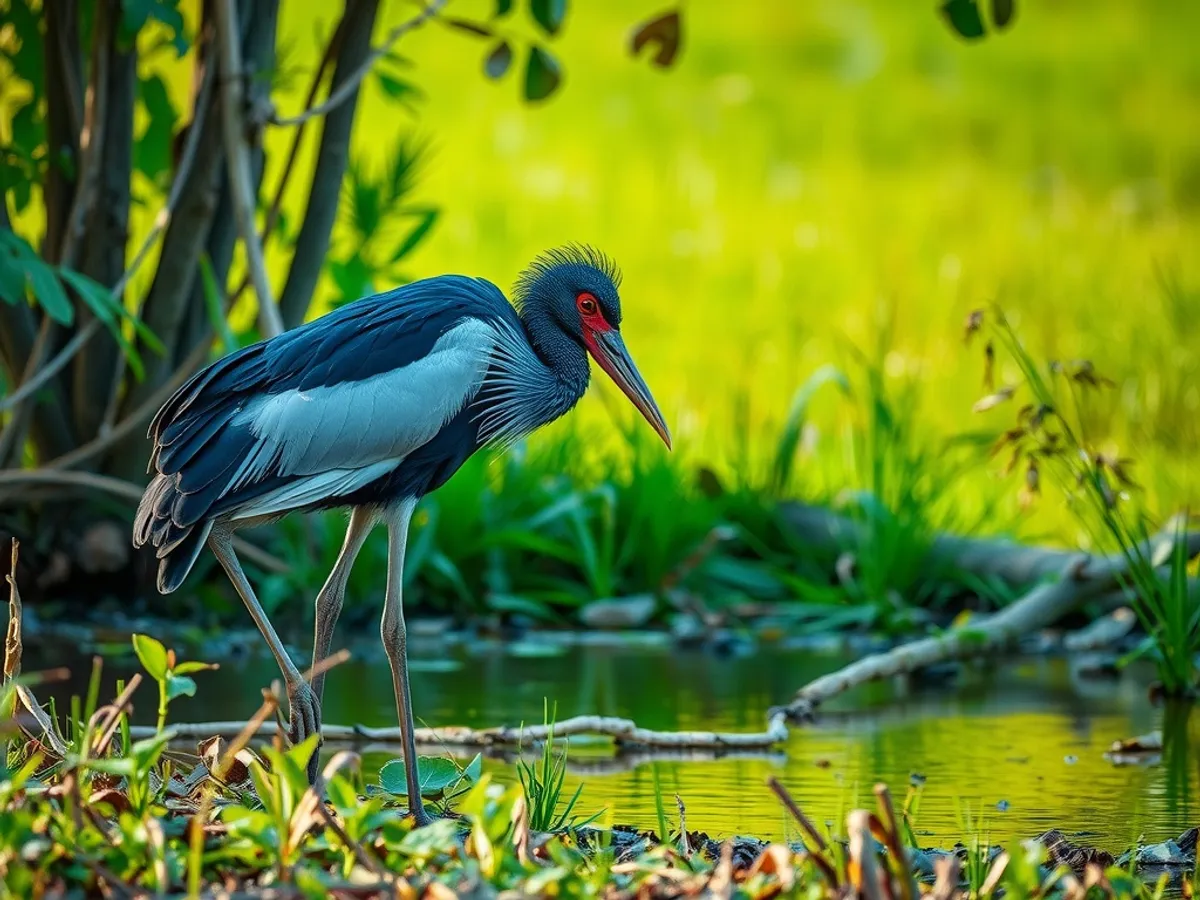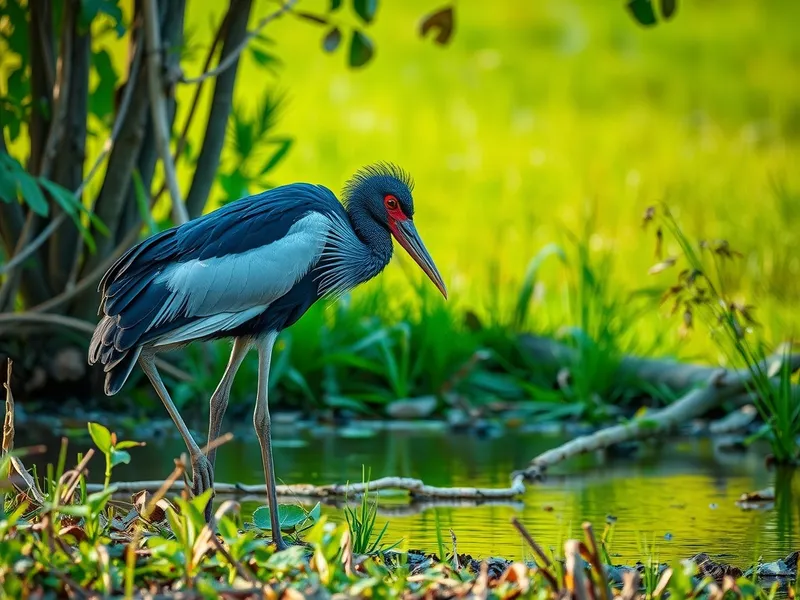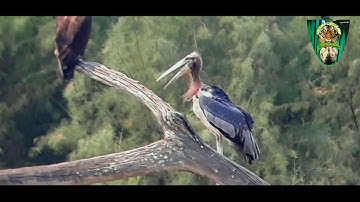
Greater Adjutant
Leptoptilos dubius

Meet the Greater Adjutant
The Greater Adjutant is a large wading bird and one of the rarest storks in the world. Distinctive for its massive wedge-shaped bill, bare head and neck, and prominent inflatable neck pouch, it reaches up to 1.5 meters in height. Once widespread across South and Southeast Asia, its population is now restricted mainly to parts of India and Cambodia. This scavenger plays a crucial role in its ecosystem by cleaning up carrion and organic waste, but faces threats from habitat loss, pollution, and hunting.
Classification
Bird
Habitat
Wetlands, marshes, and urban garbage dumps
Diet
Carnivore
Lifespan
25-30 years
Conservation
Endangered
Weight
5-8 kg
📖Fascinating Facts
Unique Appearance
The Greater Adjutant has a bald head, a large yellow inflatable neck pouch, and a heavy, downward-curved bill.
Nature's Cleaner
It is a scavenger, feeding on carrion, carcasses, and refuse, helping to keep wetlands and urban areas clean.
Colonial Nester
Greater Adjutants nest in large colonies, sometimes sharing trees with hundreds of other birds, often near human habitation.
📋Detailed Description
The Greater Adjutant (Leptoptilos dubius) is a strikingly large stork, standing 120–150 cm tall, with a wingspan reaching up to 250 cm and weighing between 5 and 8 kg. Its most distinctive features include a massive, wedge-shaped yellowish bill (up to 33 cm long), a naked, dark-skinned head and neck, and a prominent, inflatable gular pouch hanging from the lower neck, used in courtship and vocalization. The plumage is predominantly dark grey above, with white underparts and a ruff of white feathers at the base of the neck. Juveniles are duller, with more feathering on the head and neck. The legs are long and pale, adapted for wading in shallow waters. The eyes are relatively small, giving the bird a stern expression. Greater Adjutants are highly specialized scavengers, often seen soaring on thermals with vultures or foraging at garbage dumps and wetlands. They are generally solitary or found in small groups outside the breeding season, but form loose colonies during nesting. Their flight is powerful and direct, with deep, slow wingbeats. The species is known for its upright, stiff gait on the ground, which, along with its imposing stature, inspired its English name.
💡 Did you know?
At one point, the Greater Adjutant was considered a nuisance in urban areas, but now its largest breeding colonies are protected by local communities as a conservation success story.
🔬Research & Sources
Wikipedia Summary
The greater adjutant is a member of the stork family, Ciconiidae. Its genus includes the lesser adjutant of Asia and the marabou stork of Africa. Once found widely across southern Asia and mainland southeast Asia, the greater adjutant is now restricted to a much smaller range with only three breeding populations; two in India, one in the north-eastern state of Assam and a smaller one around Bhagalpur; and another breeding population in Cambodia. They disperse widely after the breeding season. This large stork has a massive wedge-shaped bill, a bare head and a distinctive neck pouch. During the day, it soars in thermals along with vultures with whom it shares the habit of scavenging. They feed mainly on carrion and offal; however, they are opportunistic and will sometimes prey on vertebrates. The English name is derived from their stiff "military" gait when walking on the ground. Large numbers once lived in Asia, but they have declined to the point of endangerment. The total population in 2008 was estimated at around a thousand individuals. In the 19th century, they were especially common in the city of Calcutta, where they were referred to as the "Calcutta adjutant" and included in the coat of arms for the city. Known locally as hargila and considered to be unclean birds, they were largely left undisturbed but sometimes hunted for the use of their meat in folk medicine. Valued as scavengers, they were once depicted in the logo of the Calcutta Municipal Corporation.
Last Modified: 5/12/2025
🎭Behavior & Social Structure
Greater Adjutants are primarily diurnal, spending early mornings and late afternoons foraging for food, while resting or preening during the hottest parts of the day. Their feeding behavior is opportunistic; they consume a wide variety of carrion, offal, and refuse, but will also hunt live prey such as fish, amphibians, reptiles, small mammals, and even other birds. They use their strong bills to probe, tear, and manipulate food, often competing with vultures and other scavengers at carcasses or dumps. Social interactions are generally limited outside the breeding season, with individuals maintaining distance, but during nesting, they may display complex courtship behaviors including bill-clattering, pouch inflation, and mutual preening. Vocalizations are rare, consisting mainly of bill rattling and low guttural sounds, as storks lack a syrinx for complex calls. Roosting occurs in tall trees, often communally, especially near breeding sites.
👶Reproduction & Life Cycle
Breeding occurs annually, typically from November to March in India and slightly later in Cambodia, coinciding with the dry season. Greater Adjutants are colonial nesters, building large stick nests high in tall trees, often in close proximity to other pairs. Clutch size ranges from 2 to 4 chalky white eggs, which are incubated for about 28–30 days by both parents. Both male and female participate in nest building, incubation, and feeding the chicks by regurgitation. Chicks are altricial, hatching naked and helpless, and remain in the nest for 90–100 days before fledging. Parental care is intensive, with adults shading the young from sun and rain and defending the nest from potential predators such as crows, kites, and monitor lizards. Juveniles remain dependent on parents for several weeks post-fledging before dispersing.
🛡️Adaptations & Survival
The Greater Adjutant's adaptations for scavenging include a robust, powerful bill capable of tearing tough flesh, and a bare head and neck that reduce feather fouling when feeding on carrion. The inflatable gular pouch may play a role in thermoregulation, courtship display, and sound production. Their long legs and partially webbed feet enable efficient wading in wetlands, while their broad wings and strong flight muscles allow them to soar for long distances in search of food. Behavioral flexibility is notable, as they exploit both natural wetlands and anthropogenic habitats like garbage dumps. Their high tolerance for human-altered landscapes is unusual among large storks, though it also exposes them to new risks.
📚Research Sources
🎨Cultural Significance
Historically, the Greater Adjutant was a familiar sight in cities like Kolkata (formerly Calcutta), where it was valued for its role in waste disposal and featured in the city’s coat of arms and municipal logos. Locally known as 'hargila' in Assam, the bird has been stigmatized as unclean, but recent conservation initiatives have sought to change perceptions, celebrating it as a symbol of ecological health and community pride. In some regions, body parts were used in folk remedies, though this practice has declined. The species has become a flagship for wetland conservation in Northeast India, with grassroots campaigns and festivals raising awareness and support for its protection.
🔬Recent Research & Discoveries
Recent research has focused on the species' adaptability to urban environments, breeding biology, and the impact of pollutants from garbage dumps on health and reproductive success. Satellite telemetry studies have revealed extensive post-breeding dispersal, with some individuals traveling over 500 km. Conservation biologists have documented the success of community-based nest protection programs in Assam, which have significantly increased fledging rates. Ongoing studies are investigating genetic diversity among the fragmented populations and the role of traditional ecological knowledge in conservation. The Greater Adjutant is now a model species for human-wildlife coexistence in rapidly urbanizing landscapes.
🎥Wildlife Videos

HARGILA – The Greater Adjutant Stork: A Celebrated Documentary by Dr. Parthasarathi Mahanta, IPS
HARGILA – The Greater Adjutant Stork, a compelling short documentary directed by senior police officer and filmmaker Dr.
Pi Media Production

Meet the Army of Women Saving India’s Rarest Stork | WILD HOPE
In the northeastern part of India, the greater adjutant stork has been considered an ill omen for generations, and the endangered ...
Nature on PBS

Wild You Were Sleeping Episode 2: Meet the Greater Adjutant Stork | The Quint
Standing at five feet tall with a wingspan of about eight feet, the Greater Adjutant Stork has now become rare but was once found ...
The Quint

Greater Adjutant
Fotopro E9 Nitecore UNK1 | Carry Speed FS Pro OSKA Nik EN-EL 15 Toshiba FlashAir™ W-04 64GB MUSIC Mark Anthony ...
Sevendays of Creation

Greater Adjutant Stork- Rupak Das || Nature & Wildlife Moments
The Greater adjutant (Leptoptilos dubius) is known as "Hargila" in Assamese. Greater adjutants are the member of stork family.
Rupak Das Nature & Wildlife Moments

The Greater Adjutant Stork.
Kaziranga Tiger Reserve, #Kaziranga National Park, #Kaziranga, #Save the Rhino #Save the Tiger, #Save the Nature 2nd ...
Green Forest Kaziranga
🌍Habitat Information
The Greater Adjutant typically inhabits Wetlands, marshes, and urban garbage dumps environments. Greater Adjutants have adapted to their environments with specialized features and behaviors.
Primary Habitat:
Wetlands, marshes, and urban garbage dumps
More detailed habitat information will be available soon.
🛡️Conservation Status
The Greater Adjutant is currently classified as Endangered. Conservation efforts are crucial for preserving this species for future generations.
Common Threats:
- 🏠Habitat loss and fragmentation
- 🌡️Climate change impacts
- 🎯Hunting and poaching
- 🏭Human-wildlife conflict
⚠️Threats & Conservation Challenges
The primary threats to the Greater Adjutant include habitat loss due to wetland drainage, deforestation, and urban expansion, as well as disturbance and destruction of nesting trees. Pollution, especially from pesticides and heavy metals at garbage dumps, poses health risks. Direct persecution, egg collection, and hunting for traditional medicine have also contributed to declines. The species is highly sensitive to changes in food availability and nesting site security. Current global population estimates (2023) range from 1,200 to 1,800 mature individuals, with the largest breeding colony in Assam, India. Conservation challenges include securing nesting sites, mitigating human-wildlife conflict, and promoting community-based protection efforts. Intensive conservation action has led to some local population increases, but the species remains Endangered (IUCN Red List).
🔬Scientific Classification
Scientific Name
Leptoptilos dubius
Classification Hierarchy
🔍 About Taxonomic Classification
Taxonomic classification is a hierarchical system used by scientists to classify and organize living organisms based on shared characteristics and evolutionary relationships.
The system moves from broad categories (Kingdom) to increasingly specific ones, with each animal's scientific name typically consisting of its Genus and species.
📝Community Notes
Share your observations and insights about the Greater Adjutant with our community of wildlife enthusiasts.
Join Our Community
Sign in to share your observations and connect with fellow wildlife enthusiasts.
Sign In to ContributeNo community notes yet
Be the first to share your observations about the Greater Adjutant!
Explore Greater Adjutant
Select a tab above to learn more about this amazing animal.
📸Photo Gallery
No photos available for this animal yet.
🌟Discover More Wildlife
Continue your journey of discovery with more fascinating animals from our database
